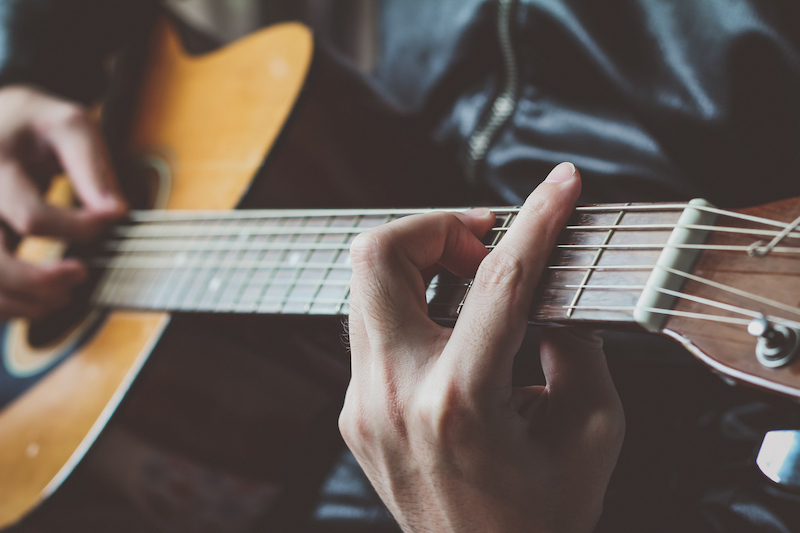Guitar playing is a great exercise and can be lots of fun for listeners as well as practitioners. Because it is a ways to express yourself more freely, playing lead guitar is also one of the most sought after skills by musicians worldwide.
What is lead guitar? Lead guitar is the style of playing where the guitar plays the melody of the music. This may happen when the guitar is the main instrument, such as in an instrumental work. More frequently, it happens when the guitar is playing a solo in a song. This is common in popular styles such as Rock, Blues, and Country. It is also common in classical styles as well.
Playing lead guitar is not much different from playing other guitar styles, but it involves more practice, and a very particular skills set of skills. Below, I list a set of things that you need to learn to play effectively lead guitar.
Playing Guitar Scales
An important skill for every player who wants to play lead guitar is to know the individual notes from particular scales. This is also something that many people have difficulty with. However, with a little practice, you’ll see that you can quickly make improvements in this skill.
A scale is a set of notes that are used in a song, and are defined by the major or minor key in which the music is written. For example, a song written and performed in the key of major C will have seven major notes in its scale. These are traditionally denoted as C, D, E, F, G, A, and B, which are the white notes in the piano. With these seven sounds, one can create any number of solos when playing in the key of C.
Another scale that is very used in solos is the pentatonic scale. This scale is a variation of the major scale where you take only five notes, instead of seven. The five notes used are C,D,E,G,A. With these five notes you easily play solos for many songs, specially in the blues and rock styles.
Like the two examples above, each key will have a different set of notes that can be part of a solo. Learning these notes is what takes time, because you have to be prepared to play on scale in each song that you play lead.
Scale Patterns
The good news is that the guitar simplifies the process of learning scales. If you know the scale for a single key, say G, then you can use the same finger pattern to play in other keys by just “sliding” the pattern over the guitar’s neck.
You can use that same pattern to play a similar scale in the key of A, or B, or C, by sliding the pattern down the neck. Or you can play in the scale of F by sliding up in the guitar neck by one full tone (two frets).
Guitar Scales
There is a large number of guitar scales, which make it seem very difficult and hard to practice. However, you’ll realize that almost all scales are just variations of the major and minor scales. The major scale is the one of the white keys in the piano.
All major scales use the same pattern in the guitar, just moving the same pattern up and down. Another possible variations is starting the pattern on a particular string. For example, starting the scale on the 6th string will generate a pattern, and starting it in the 5th string will generate another. All these patterns can be repeated.
Another change in the pattern is the initial finger in which you start the scale. If you start the scale in the 5th string with the finger number 1 (of the left hand), this will generate a pattern, but if you start with finger 4, this will results in a different pattern. However, all these patterns can be reused up and down the neck.
The easiest way to do is to learn a simple pattern first, and then practice other patterns as you gain more experience.
The natural minor scale is also related to the major scale. If you start the notes of the C major scale in A, then you will have the same notes as the A minor scale. Thus, if you learn the notes of the C major scale, you already know all nodes of the A minor scale. You can also move the scale up and down, to find B minor, C minor, and other scales.
How to Use Scales
Playing the solo guitar requires that you learn playing the scales, as stated above. These scales can then be used to pick the notes of simple songs. At this point, you’ll be able to play songs note by note, using the scales that you learned.
Then, when you learn the right notes for a song, you can also start improvising, that is, playing variations on the song over the same scale. Since you know the scale for a song, this is an easy thing to do. You just select different notes in the scale, in a way that sounds harmonious for that particular song. That requires daily practice, but is not so difficult.
Playing the lead guitar is great fun. You can practice a lot of variations quickly, so it is a very good way to sharp your skills as a guitar player.
If you are an adult player, who want to practice these skills and have great fun, you can find good resources using the internet. One resource that I recommend to my students is this (click here to see my full article).
